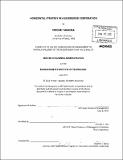| dc.contributor.advisor | Arnoldo C. Hax. | en_US |
| dc.contributor.author | Takaoka, Hiroaki | en_US |
| dc.contributor.other | Sloan School of Management. | en_US |
| dc.date.accessioned | 2011-09-13T17:53:18Z | |
| dc.date.available | 2011-09-13T17:53:18Z | |
| dc.date.copyright | 2011 | en_US |
| dc.date.issued | 2011 | en_US |
| dc.identifier.uri | http://hdl.handle.net/1721.1/65792 | |
| dc.description | Thesis (M.B.A.)--Massachusetts Institute of Technology, Sloan School of Management, 2011. | en_US |
| dc.description | Cataloged from PDF version of thesis. | en_US |
| dc.description | Includes bibliographical references (p. 123-125). | en_US |
| dc.description.abstract | Competition in the business world is becoming harsher as markets shrink due to the financial crisis of the late 2000s. Firms have to leverage their core competencies to survive by attracting more customers and attaining more efficient operations. In such circumstances, diversified corporations that run multiple businesses have opportunities to differentiate themselves by implementing horizontal strategies. Unfortunately, a horizontal strategy never happens spontaneously. There must be strong control and solid process to realize synergy. Furthermore, there are no generalized or standardized methods for developing and implementing a horizontal strategy. Executing this kind of corporate strategy is very difficult in the real world. However, if the firm could establish a solid infrastructure to implement a horizontal strategy, it would be a sustainable competitive advantage that could not be easily imitated. In fact, there are many firms that enjoy synergy by implementing a horizontal strategy using various approaches. They differentiate their products and services, reduce operating costs, attract and involve customers, and create high barriers to prevent invasion by rivals. A horizontal strategy is a powerful business tool that enhances a firm's capabilities and increases its corporate value. In this thesis, I will investigate several historical theories of horizontal strategy and attempt to integrate their core concepts. I will examine four actual diversified corporations to determine how they utilize their horizontal strategy, while also identifying their critical driving forces and challenges. Then I will propose a practical process for creating and implementing a horizontal strategy. In my proposal, I will also recommend appropriate evaluation system and strong leadership because the lack of them frequently results in failure. | en_US |
| dc.description.statementofresponsibility | by Hiroaki Takaoka. | en_US |
| dc.format.extent | 125 p. | en_US |
| dc.language.iso | eng | en_US |
| dc.publisher | Massachusetts Institute of Technology | en_US |
| dc.rights | M.I.T. theses are protected by
copyright. They may be viewed from this source for any purpose, but
reproduction or distribution in any format is prohibited without written
permission. See provided URL for inquiries about permission. | en_US |
| dc.rights.uri | http://dspace.mit.edu/handle/1721.1/7582 | en_US |
| dc.subject | Sloan School of Management. | en_US |
| dc.title | Horizontal strategy in a diversified corporation | en_US |
| dc.type | Thesis | en_US |
| dc.description.degree | M.B.A. | en_US |
| dc.contributor.department | Sloan School of Management | |
| dc.identifier.oclc | 749908785 | en_US |
